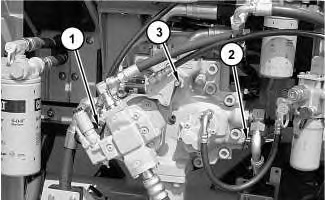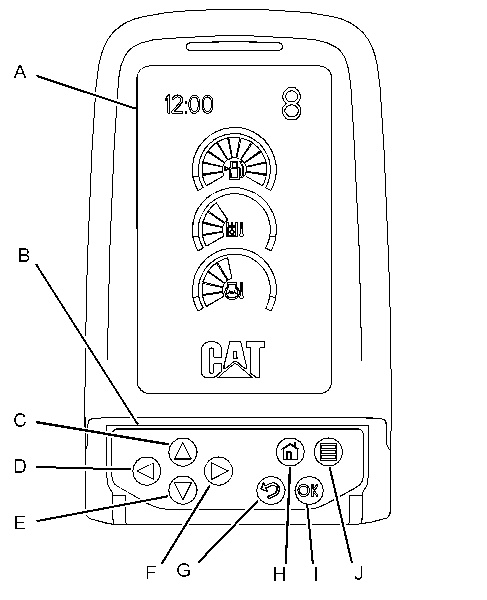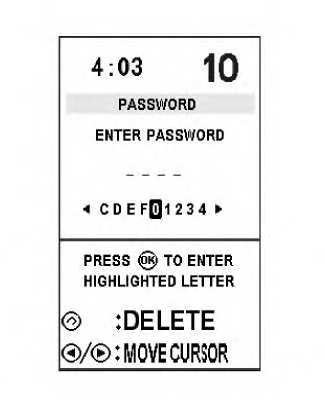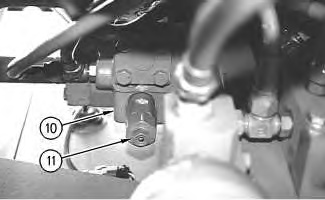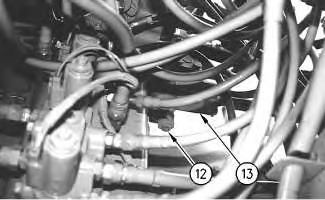| Required Tools | ||
|---|---|---|
| Part Number | Description | Qty |
| 8T-0861 | Pressure Gauge ( 60000 kPa (8700 psi)) |
2 |
| 8T-0856 | Pressure Gauge ( 6000 kPa (870 psi)) |
1 |
Note: A temporary setting of the main relief valve pressure is required before any line relief valve pressure setting is adjusted. Refer to the adjustment procedures in Testing and Adjusting, “Relief Valve (Main) – Test and Adjust”.
Test
- Position the machine on level ground.
- Stop the engine.
- Release the pressure in the hydraulic system. Refer to Testing and Adjusting, “Hydraulic System Pressure – Release”.
- Connect a 60000 kPa (8700 psi) pressure gauge to pressure tap (1) .
|
|
|
|
|
|
| Illustration 1 | g01266656 |
|
Pump compartment (1) Pressure tap (drive pump pressure) (2) Pressure tap (idler pump pressure) (3) Pressure tap (power shift pressure) |
|
- Connect a 60000 kPa (8700 psi) pressure gauge to pressure tap (2) .
- Connect a 6000 kPa (870 psi) pressure gauge to pressure tap (3) to monitor power shift pressure.
- Start the engine.
- Increase the hydraulic oil temperature to 55° ± 5°C (131° ± 9°F).
- Start Service Mode and input a fixed power shift pressure. Refer to Table 2 for the correct pressure setting of each hydraulic circuit.
- Press menu key (J) .
Note: Make sure that the engine speed dial is set correctly. Refer to Table 2 for the correct setting.
Note: If more than 30 seconds pass between pushing the keys on the keypad, the menu mode will be canceled and the previous display will be restored to message display (A) .
- Press right key (F) in order to highlight “SERVICE” menu option.
- After the “SERVICE” option is highlighted, press OK key (I) .
- After OK key (I) is pressed, the screen in Illustration 3 will be displayed. The password for the service menu is “FFF2”. The keys for direction are used to input the password. Press left key (D) or right key (F) in order to change the position of the flashing character. Press OK key (I) in order to enter the highlighted character.
Illustration 3 g01148206 - After entering the last letter of the password, the monitor will continue with the “SERVICE” screen.
- Repeatedly press down key (E) in order to highlight the “DEVICE TEST” line on the display.
- After the “DEVICE TEST” line is highlighted, press OK key (I) .
- Once the “DEVICE TEST” screen is displayed, press down key (E) until “POWER SHIFT PRES” appears on the display.
- When “POWER SHIFT PRES” is highlighted, press OK key (I) .
- Place the machine controls at the following settings: engine speed dial 10 and AEC switch OFF. Refer to Testing and Adjusting, “Engine Performance – Test (Engine Speed)” for engine rpm settings.
Note: Press OK key (I) within 5 seconds after completion of Step 9.j in order to ensure high idle.
- The “POWER SHIFT PRES” will now be displayed. Line 4 of the display will now change to a numeric value. These characters represent the power shift pressure (kPa).
- Press left key (D) or right key (F) in order to increase or decrease the numeric value that is displayed on line 4 of the display. Pressing left key (D) decreases the power shift pressure. Pressing right key (F) increases the power shift pressure.
Note: The value for power shift pressure on the monitor may not always match the pressure reading on the pressure gauge. Adjust the value on the monitor until the desired power shift pressure is attained on the pressure gauge that is connected to the pressure tap for power shift pressure. Make sure that the actual power shift pressure on the pressure gauge is correct for each hydraulic circuit. Refer to Table 2 for the correct power shift pressure.
Note: To prevent a change in power shift pressure during the relief valve adjustment, do not exit the “DEVICE TEST” screen and do not turn the engine start switch to the OFF position.
Note: Refer to Systems Operation, “Monitoring System” for additional information on Service Mode.
- Press menu key (J) .
|
|
|
|
|
|
| Illustration 2 | g01186552 |
|
Monitor (A) Display (B) Keypad (C) Up key (D) Left key (E) Down key (F) Right key (G) Back key (H) Home key (I) OK key (J) Menu key |
|
- The pressure setting for both the head end of the boom cylinders and the rod end of the stick cylinder is 38000 + 2000 – 1000 kPa (5511 + 290 – 145 psi). The pressure setting for both the rod end of the boom cylinders and the head end of the stick cylinder is 37000 + 2000 – 1000 kPa (5366 + 290 – 145 psi). The pressure setting for both the head end and the rod end of the bucket cylinder is 37000 + 2000 – 1000 kPa (5366 + 290 – 145 psi).
|
|
|
|
|
|
| Illustration 4 | g01345942 |
|
Main control valves (front view) (7) Line relief valve (boom cylinder rod end) (8) Line relief valve (bucket cylinder head end) (9) Line relief valve (stick cylinder head end) (11) Line relief valve (boom cylinder head end) (12) Line relief valve (stick cylinder rod end) (16) Line relief valve (bucket cylinder rod end) |
|
The following line relief valves are located on top of the main control valves: boom cylinder rod end, bucket cylinder head end and stick cylinder head end. The line relief valve for the bucket cylinder rod end is located under the main control valves and opposite the line relief valve for bucket cylinder head end (8).
|
|
|
|
|
|
| Illustration 5 | g00671871 |
|
Main control valve (bottom view) (10) Boom drift reduction valve (11) Line relief valve (boom cylinder head end) |
|
Line relief valve (11) (boom cylinder head end) is located on boom drift reduction valve (10).
|
|
|
|
|
|
| Illustration 6 | g00671874 |
|
Main control valve (bottom view) (12) Line relief valve (stick cylinder rod end) (13) Stick drift reduction valve |
|
Line relief valve (12) (stick cylinder head end) is located on stick drift reduction valve (13).
|
|
|
|
|
|
| Illustration 7 | g01201790 |
|
Line relief valve (typical example) (14) Locknut (15) Adjustment screw |
|
Note: Turn adjustment screw (15) clockwise in order to increase the pressure. Turn adjustment screw (15) counterclockwise in order to decrease the pressure.
Note: After relief valve adjustments, cancel Service Mode.
Note: Return the main relief valve pressure to the specified setting after testing and adjusting any line relief valve. Refer to Testing and Adjusting, “Relief Valve (Main) – Test and Adjust” for the main relief valve pressure setting.
| Line Relief Valve Pressure Settings | |||
|---|---|---|---|
| Standard Configuration | |||
| Cylinder | Cylinder Position | Power Shift Pressure | Relief Pressure Setting |
| Bucket | Retracted | 3700 ± 50 kPa (537 ± 7 psi) Speed Dial 2 |
37000 + 2000 – 1000 kPa (5366 + 290 – 145 psi) |
| Extended | |||
| Boom | Retracted | 3700 ± 50 kPa (537 ± 7 psi) Speed Dial 2 |
37000 + 2000 – 1000 kPa (5366 + 290 – 145 psi) |
| Extended | 2500 ± 50 kPa (363 ± 7 psi) Speed Dial 2 |
38000 + 2000 – 1000 kPa (5511 + 290 – 145 psi) | |
| Stick | Retracted | 2500± 50 kPa (363 ± 7 psi) Speed Dial 2 |
38000 + 2000 – 1000 kPa (5511 + 290 – 145 psi) |
| Extended | 2800 ± 50 kPa (406 ± 7 psi) Speed Dial 2 |
37000 + 2000 – 1000 kPa (5366 + 290 – 145 psi) | |
Adjustment (Boom Cylinders)
Note: Make sure that the engine speed dial and the power shift pressure for the BOOM RAISE hydraulic circuit is set correctly. Refer to Table 2 for the correct setting.
- To adjust the line relief valve pressure setting of the boom cylinder head end, move the joystick for the boom until the boom is at the full BOOM RAISE position (full extension of boom cylinders). Hold the joystick for the boom in this position.
- Check the pressure in the boom cylinder head end on the pressure gauge at pressure tap (1) .
- Return the joystick for the boom to the NEUTRAL position.
- The pressure gauge reading should be 38000 + 2000 – 1000 kPa (5511 + 290 – 145 psi). Refer to Table 2. If the pressure gauge reading at pressure tap (1) is not within the specification, adjust line relief valve (11) .
- In order to adjust line relief valve (11), loosen locknut (14) on the boom line relief valve. Turn adjustment screw (15) until the pressure gauge reading at pressure tap (1) is 38000 + 2000 – 1000 kPa (5511 + 290 – 145 psi).
Note: Always make final pressure adjustment on pressure rise.
- Tighten locknut (14) to 20 ± 2 N·m (15 ± 1 lb ft) on line relief valve (11) .
- Loosen locknut (14) on the line relief valve for the BUCKET OPEN function. Turn adjustment screw (15) by one quarter turn in a clockwise direction. Tighten locknut (14) on the line relief valve for the bucket cylinder.
Note: In order to adjust the line relief valve pressure setting for the boom cylinder rod end, a temporary adjustment of the line relief valve for the bucket cylinder rod end must be performed.
Note: Make sure that the engine speed dial and the power shift pressure for the BOOM DOWN hydraulic circuit is set correctly. Refer to Table 2 for the correct setting.
- Move the joystick for the bucket until the bucket is at the full BUCKET OPEN position (full retraction of the bucket cylinder). Hold the joystick for the bucket in this position. At the same time, move the joystick for the boom until the boom is at the full BOOM DOWN position (full retraction of boom cylinders). Hold the joystick for the boom in this position.
- Check the pressure in the boom cylinder rod end on the pressure gauge at pressure tap (1) .
- Return the joystick for the boom to the NEUTRAL position.
- The pressure gauge reading should be 37000 + 2000 – 1000 kPa (5366 + 290 – 145 psi). If the pressure gauge reading at pressure tap (1) is not within the specification, adjust line relief valve (7) .
- In order to adjust line relief valve (7), loosen locknut (14) on the boom line relief valve. Turn adjustment screw (15) until the pressure gauge reading at pressure tap (1) is 37000 + 2000 – 1000 kPa (5366 + 290 – 145 psi). Refer to Table 2.
Note: Always make final pressure adjustment on pressure rise.
- Tighten locknut (14) to 20 ± 2 N·m (15 ± 1 lb ft)on line relief valve (7) .
- After completion of line relief valve adjustment for the boom cylinders, return the line relief valve pressure setting of the bucket to the specified pressure setting.
Note: If an appropriate location is not available to fully extend the boom cylinders, exchange the functions of the boom line relief valves. Remove the line relief valve for the boom cylinder head end and the line relief valve for the boom cylinder rod end from the main control valve. Exchange the location of the line relief valves. Adjust the pressure of the boom line relief valve that is now attached in the head end. After completion of line relief valve adjustment, return the respective line relief valves to the original locations.
Adjustment (Stick Cylinder)
Note: Make sure that the engine speed dial and the power shift pressure for the STICK OUT hydraulic circuit is set correctly. Refer to Table 2 for the correct setting.
- To adjust the line relief valve pressure setting of the stick cylinder rod end, move the joystick for the stick until the stick is at the full STICK OUT position (full retraction of stick cylinder). Hold the joystick for the stick in this position.
- Check the pressure in the stick cylinder rod end on the pressure gauge at pressure tap (2) .
- Return the joystick for the stick to the NEUTRAL position.
- The pressure gauge reading should be 38000 + 2000 – 1000 kPa (5511 + 290 – 145 psi). If the pressure gauge reading at pressure tap (2) is not within the specification, adjust line relief valve (12) .
- In order to adjust line relief valve (12), loosen locknut (14) on the stick line relief valve. Turn adjustment screw (15) until the pressure gauge reading at pressure tap (2) is 38000 + 2000 – 1000 kPa (5511 + 290 – 145 psi). Refer to Table 2.
Note: Always make final pressure adjustment on pressure rise.
- Tighten locknut (14) to 20 ± 2 N·m (15 ± 1 lb ft) on line relief valve (12) .
- To adjust the line relief valve pressure setting of the stick cylinder head end, move the joystick for the stick until the stick is at the full STICK IN position (full extension of stick cylinder). Hold the joystick for the stick in this position.
Note: Make sure that the engine speed dial and the power shift pressure for the STICK IN hydraulic circuit is set correctly. Refer to Table 2 for the correct setting.
- Check the pressure in the stick cylinder head end on the pressure gauge at pressure tap (2) .
- Return the joystick for the stick to the NEUTRAL position.
- The pressure gauge reading should be 37000 + 2000 – 1000 kPa (5366 + 290 – 145 psi). Refer to Table 2. If the pressure gauge reading at pressure tap (2) is not within the specification, adjust line relief valve (9) .
- In order to adjust line relief valve (9), loosen locknut (14) on the stick line relief valve. Turn adjustment screw (15) until the pressure gauge reading at pressure tap (2) is 37000 + 2000 – 1000 kPa (5366 + 290 – 145 psi). Refer to Table 2.
Note: Always make final pressure adjustment on pressure rise.
- Tighten locknut (14) to 20 ± 2 N·m (15 ± 1 lb ft) on line relief valve (9) .
Adjustment (Bucket Cylinder)
Note: Make sure that the engine speed dial and the power shift pressure for the BUCKET CLOSE hydraulic circuit is set correctly. Refer to Table 2 for the correct setting.
- To adjust the line relief valve pressure setting of the bucket cylinder head end, move the joystick for the bucket until the bucket is at the full BUCKET CLOSE position (full extension of bucket cylinder). Hold the joystick for the bucket in this position.
- Check the pressure in the bucket cylinder head end on the pressure gauge at pressure tap (1) .
- Return the joystick for the bucket to the NEUTRAL position.
- The pressure gauge reading should be 37000 + 2000 – 1000 kPa (5366 + 290 – 145 psi). Refer to Table 2. If the pressure gauge reading at pressure tap (2) is not within the specification, adjust line relief valve (8) .
- In order to adjust line relief valve (8), loosen locknut (14) on the bucket line relief valve. Turn adjustment screw (15) until the pressure gauge reading at pressure tap (2) is 37000 + 2000 – 1000 kPa (5366 + 290 – 145 psi). Refer to Table 2.
Note: Always make final pressure adjustment on pressure rise.
- Tighten locknut (14) to 20 ± 2 N·m (15 ± 1 lb ft) on line relief valve (8) .
- To adjust the line relief valve pressure setting of the bucket cylinder rod end, move the joystick for the bucket until the bucket is at the full BUCKET OPEN position (full retraction of bucket cylinder). Hold the joystick for the bucket in this position.
Note: Make sure that the engine speed dial and the power shift pressure for the BUCKET OPEN hydraulic circuit is set correctly. Refer to Table 2 for the correct setting.
- Check the pressure in the bucket cylinder rod end on the pressure gauge at pressure tap (1) .
- Return the joystick for the bucket to the NEUTRAL position.
- The pressure gauge reading should be 37000 + 2000 – 1000 kPa (5366 + 290 – 145 psi). If the pressure gauge reading at pressure tap (2) is not within the specification, adjust the line relief valve.
- In order to adjust the line relief valve, loosen locknut (14) on the bucket line relief valve. Turn adjustment screw (15) until the pressure gauge reading at pressure tap (2) is 37000 + 2000 – 1000 kPa (5366 + 290 – 145 psi). Refer to Table 2.
Note: Always make final pressure adjustment on pressure rise.
- Tighten locknut (14) to 20 ± 2 N·m (15 ± 1 lb ft) on the line relief valve.
- Reset the main relief valve pressure to the correct setting. Refer to the adjustment procedures in Testing and Adjusting, “Relief Valve (Main) – Test and Adjust”.
